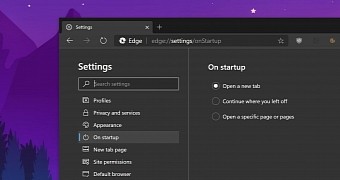Microsoft Edge browser is now available for everyone on Windows and macOS after the migration to the Chromium engine, with dedicated versions on Windows 7, Windows 8, Windows 8.1, Windows 10, and Apple’s Macs.
Microsoft says a Linux version is also coming, but no specifics are available for now.
As for the Windows 10 version, Microsoft has recently started the automatic rollout of the browser, and the whole thing happens via Windows Update. The new Chromium-based browser replaces the existing Edge legacy version as the new default on Windows 10.
Microsoft Edge automatically offered to devices via Windows Update made some call it a “forced update,” but as I told you recently, this isn’t any means supposed to be a forced install. And it’s all because Microsoft has already released a toolkit to block the update, while also making everyone aware of its plans many months in advance.
More recently, however, some discovered another weird behavior that a number of Windows 10 users might consider another attempt to forced them to stick with Microsoft Edge.
The new Chromium browser is automatically starting when booting into Windows 10, even if users didn’t specifically configure the app to do it. In other words, you start Windows, log in to the OS, boot to the desktop, and then Microsoft Edge automatically launches too.
Microsoft says this is a bug, and the company is investigating, but the company also needs more help to figure out the whole thing. Additional information on how to send feedback to the software giant on this is available here.
“We've heard from our community that some versions of Microsoft Edge are automatically launching whenever users start their PCs and log into Windows, regardless of their selection in edge://settings/onStartup. It’s currently unknown whether there are any accompanying behavioral changes with this bug. If this is something that you're experiencing with Microsoft Edge, we want to know,” Microsoft explains.
The first thing you need to do is determine if Microsoft Edge is configured to run at boot. To do this in Windows 10, launch the Task Manager by simply right-clicking the taskbar > Task Manager.
Next, head over to the Startup tab and check all entries there. If Microsoft Edge is enabled, unchecking the checkbox next to it should guarantee it no longer runs on boot.
Microsoft says you should also check the Edge startup settings in the browser, but this isn’t directly related to the operating system configuration. To check out Edge startup configurations, follow this path:
Microsoft Edge > Menu > Settings > On Startup
Microsoft offers three different options in Edge browser:
- Open a new tab
- Continue where you left off
- Open a specific page or pages
At this point, however, it’s still not clear how these settings in Microsoft Edge are related to the operating system boot configuration.
The transition to the Chromium engine allowed Microsoft to make Edge a cross-platform browser. So in addition to Windows 10, it’s also offered on older Windows and non-Windows platforms, but also on mobile devices, with dedicated versions for Android and iOS also available.
However, the bug here only happens on Windows – Microsoft hasn’t confirmed only Windows 10 is affected or not, but I’m hearing that the problem happens on devices where the update was installed as an automatic download via Windows Update.
It remains to be seen how this blunder would be fixed in the coming months, but the good news is that Microsoft is investigating, so more information should be shared rather sooner than later.

 14 DAY TRIAL //
14 DAY TRIAL //